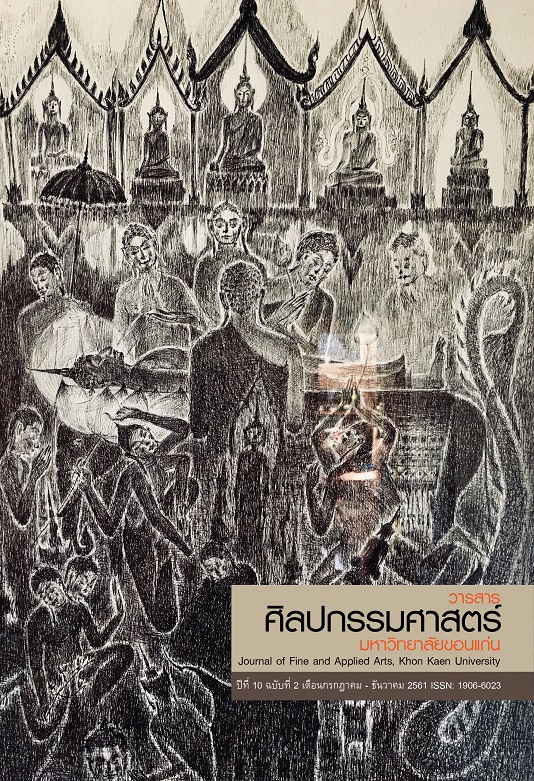Iconography of the Reclining Buddha Image I-Saan Daravati Art
Main Article Content
Abstract
This study is focus on the meaning of the iconography of the Dvaravati Reclining Buddhas in the northeastern part of Thailand (Isan). The study concerned about art forms and meaning of the dvaravati reclining buddhas in Isan. Art history research is the main methodology with the theory of cultural ecology as a complementary approach.
The target group used in the research consist of Phu Wiang reclining buddha, Phu Chum Phae district, Khon Kaen province, Phu Po reclining buddha, capital district, Karasin province, Phu Khaw reclining buddha, Sahatsakhan District, Karasin province and Cherng Doi Theparat Temple reclining buddha, capital district, Sakon Nakhon province. Data collection proceeded by the survey forms aiming on quantity and places with reclining buddhas were enshrined and descriptive analysis came at the end of the research.
The Study found that only 2 reclining buddhas demonstrated the literally Isan Dvaravati, the Phu Wiang reclining buddha and the Phu Po reclining buddha (the lower one). The second Phu Po reclining buddha (the upper one) and the Phu Khaw reclining buddha resembled each other in art forms, particularly the dressing of yellow robe for Buddhist monks with corresponded to the art form of Dvaravati reclining buddhas in other areas within Isan, differ slightly on the buddha’s faces. The Study assumed that these forms have succeeded later.
The meaning of the Dvaravati reclining Buddha in Isan is the nirvana of the Buddha. An elaborate consideration from Mahaparinibbana Sutra in the Tripitaka portrayed that there are several principles. The meaning that related to cultural and social or the arguments where to place the reclining buddha may be noted that because of moral precept and believe of the death ritual form pre-historic culture. This faith was shown by enshrined reclining buddhas over cliffs or in the caves through the northeastern part of Thailand. Both of these cultures emphasized the rituals about death, yet there are little differences in action and believes.
Article Details
Content and information in articles published in the Journal of Fine and Applied Arts of Khon Kaen University is regarded as the opinion and sole responsibility of the author(s) directly; therefore, editors are not obliged to agree to or share any responsibility with regard to the content and information that appears within these articles.
All articles, information, content, image, etc. that have been published in the Journal of Fine and Applied Arts of Khon Kaen University is the copyright of the Journal of Fine and Appllied Arts of Khon Kaen University. Any person or organization who wishes to distribute all or parts of the articles for further dissemination or other usage must first receive permission from the Journal of Fine and Applied Arts of Khon Kaen University before proceeding to do so.
References
กรุงเทพฯ: กรมศิลปากร. (2535). ศิลปะถ้ำสมัยประวัติศาสตร์ ภาคตะวันออกเฉียงเหนือ. กรุงเทพฯ : ห้างหุ่นส่วน จำกัด ป. สัมพันธ์พานิช.
กระทรวงศึกษาธิการ. (2525). พระไตรปิฎกภาษาไทยฉบับหลวง. กรุงเทพฯ กรมการศาสนา.
กลุ่มโบราณคดี สำนักศิลปากรที่ 9 ขอนแก่น. (2558). ชุมชนโบราณโนนเมือง. ขอนแก่น.
ชะเอม แก้วคล้าย. (2544) “จารึกพระพุทธไสยาสน์ภูเวียง”. ศิลปากร 44 (3) (พฤษภาคม –มิถุนายน), 56-61.
เชษฐ์ ติงสัญชลี. (2553) ลวดลายในศิลปะทวารวดี “ที่มา” และการตรวจสอบกับศิลปะอินเดีสมัยคุปตะวากาฏกะ. นครปฐม: โรงพิมพ์มหาวิทยาลัยศิลปากร.
ธนธร กิตติกานต์. (2557) มหาธาตุ. กรุงเทพฯ: มติชน.
ธิดา สาระยา. (2545). ทวารวดี ต้นประวัติศาสตร์ไทย. กรุงเทพฯ: เมืองโบราณ.
ธิดา สาระยา. (2546). อาณาจักรเจนละประวัติศาสตร์อีสานโบราณ (พิมพ์ครั้งที่ 4). กรุงเทพฯ:พิฆเณศพริ้นท์ติ้งเซ็นเตอร์.
ธิดา สาระยา. (2553) กว่าจะเป็นคนไทย. กรุงเทพฯ: เมืองโบราณ.
ผาสุข อินทราวุธ และคณะ. (ม.ป.ป.). รายงานการขุดค้นเมืองโบราณฟ้าแดดสงยาง อำเภอกมลาไสย จังหวัดกาฬสินธุ์.ขอนแก่น: สำนักงานโบราณคดีและพิพิธภัณฑสถานแห่งชาติที่ 7.
ผาสุข อินทราวุธ และคณะ. (2548). สุวรรณภูมิจากหลักฐานโบราณคดี. กรุงเทพฯ: ศักดิ์โสภาการพิมพ์.
พระศรีวิสุทธิโกศล (กิตติวัฒน์ พลวัน). (2547). การศึกษาวิเคราะห์มหาปรินิพานสูตร : ศึกษาเฉพาะการรักษาหลักพระธรรมวินัย, พุทธศาสตรมหาบัณฑิต (พระพุทธศาสนา), มหาวิทยาลัยมหาจุฬาลงกรณราชวิทยาลัย.
รุ่งโรจน์ ธรรมรุ่งเรือง. (2552). พระพุทธรูปและพระพิมพ์ทวารวดีภาคตะวันออกเฉียงเหนือ. ดุษฎีนิพนธ์ปรัชญาดุษฎีบัณฑิต, สาขาวิชาประวัติศาสตร์ศิลปะไทย,บัณฑิตวิทยาลัย, มหาวิทยาลัยศิลปากร.
ศรีศักร วัลลิโภดม,วลัยลักษณ์ ทรงศิริ, รัชนีบูล ตังคณะสิงห์. (2529). อีสาน “ความสัมพันธ์ของชุมชนที่มีคูเมืองกำแพงเมืองกับการเกิดรัฐของ ประเทศไทย”. ศิลปวัฒนธรรม, 8 (1), 130-132.
ศรีศักร วัลลิโภดม,วลัยลักษณ์ ทรงศิริ, รัชนีบูล ตังคณะสิงห์. (2546). แฉหลักฐานโบราณคดีพลิกโฉมหน้ประวัติศาสตร์ไทย แอ่งอารยธรรมอีสาน(พิมพ์ครั้งที่ 4). กรุงเทพฯ: มติชน.
ศรีศักร วัลลิโภดม,วลัยลักษณ์ ทรงศิริ, รัชนีบูล ตังคณะสิงห์. (2556). เมืองหนองหารหลวง และภูพานมหาวนาสี. กรุงเทพฯ: มูลนิธิเล็ก-ประไพ วิริยะพันธ์.
ศักดิ์ชัย สายสิงห์. (2547). ศิลปะทวารวดี : วัฒนธรรมพุทธศาสนายุคแรกเริ่มในดินแดนไทย. กรุงเทพฯ:เมืองโบราณ.
สุกัญญา เบาเนิด. (2554). โบราณคดีหลากสาระในดินแดนอีสาน-ล้านานนา. สำนักศิลปากรที่ 11 อุบลราชธานี: กรมศิลปากร.
สุจิตต์ วงษ์เทศ. (2560). งานศพยุคแรกอุษาคเนย์. กรุงเทพฯ : นาตาแฮก.
สุชีพ ปุญญานุภาพ. (2550.) พระไตรปิฎกฉบับประชาชน (พิมพ์ครั้งที่ 17). กรุงเทพฯ: มหามกุฏราชวิทยาลัย.
สุภัทรดิศ ดิศกุล, หม่อมเจ้า. (2545). ประวัติศาสตร์ศิลปะประเทศใกล้เคียง อินเดีย, ลังกา, ชวา, จาม, ขอม, พม่า, ลาว (พิมพ์ครั้งที่ 4). กรุงเทพฯ: ศิลปวัฒนธรรม.
เอเดรียน สนอดกราส. (2541). สัญลักษณ์แห่งพระสถูป, พิมพ์ครั้ง ที่ 2. กรุงเทพฯ : อมรินทร์วิชาการ.


